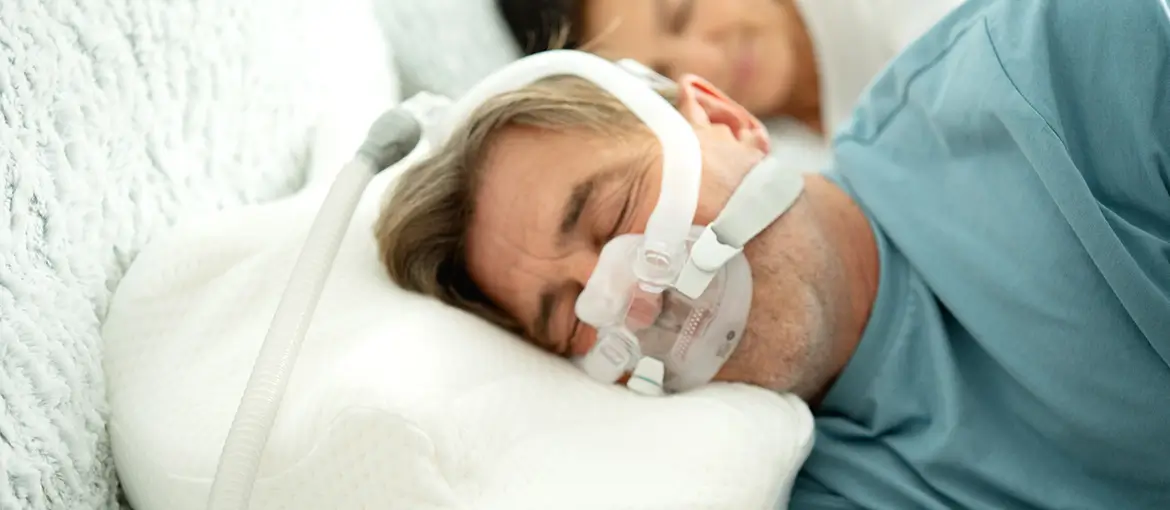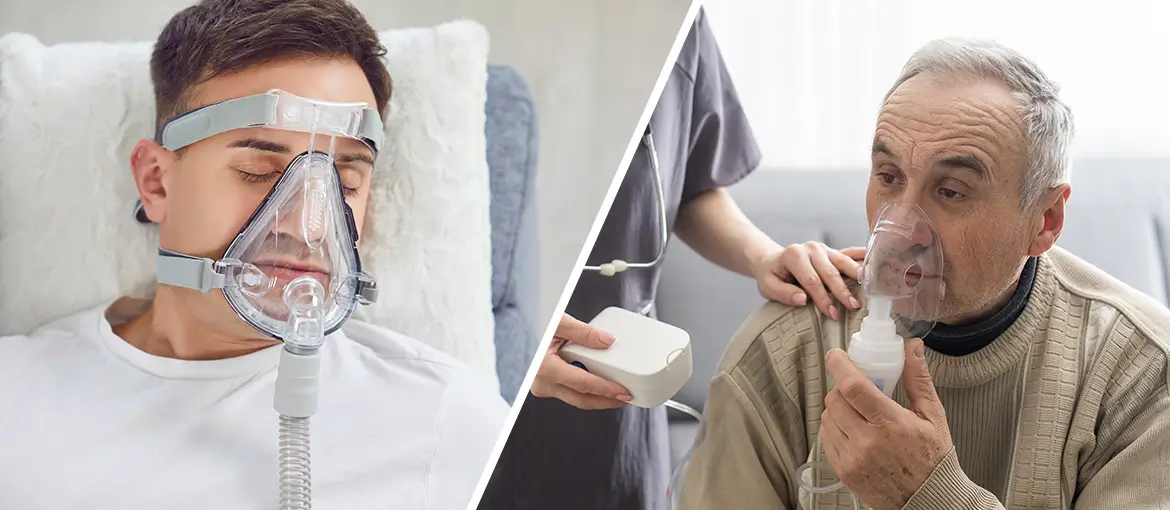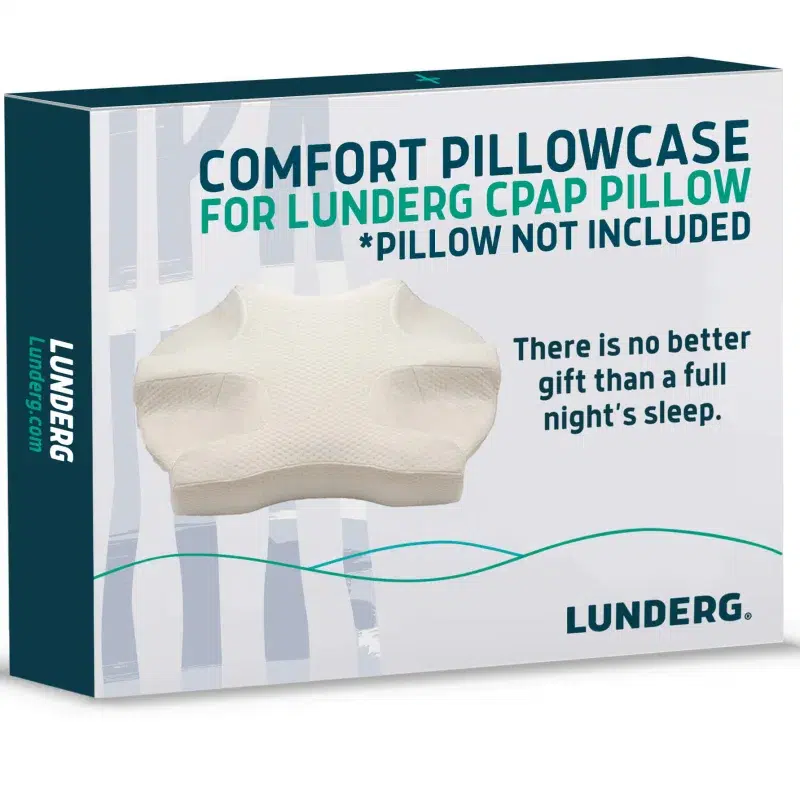Choosing the Right Sleep Apnea Therapy Device
When managing breathing-related health conditions, understanding the differences between an oxygen concentrator and CPAP machine is essential. Both devices are used to support respiratory function, but they are designed for different situations and medical needs. Managing chronic obstructive pulmonary disease (COPD) or obstructive sleep apnea (OSA) requires that you choose the right respiratory device to significantly improve your quality of life.
In this article, we’ll compare oxygen concentrators and CPAP machines, explore their functions, the conditions they treat, and outline key factors to consider when making your choice between the two. When deciding between an oxygen concentrator or a CPAP machine, be sure to consult your healthcare provider. Whatever choice you make, pair your machine with Lunderg’s sleep apnea pillow.
Defining Oxygen Concentrators and CPAP Machines
What Is an Oxygen Concentrator?
An oxygen concentrator is a medical device designed to deliver concentrated oxygen to individuals who have low blood oxygen levels. It works by taking in ambient air, filtering out nitrogen and other gases, and delivering nearly pure oxygen through a face mask. This continuous supply of oxygen helps improve breathing in patients with conditions such as COPD, pulmonary fibrosis, and other heart problems.
What Is a CPAP Machine?
A continuous positive airway pressure (CPAP) machine is a sleep therapy device used to treat obstructive sleep apnea. The machine delivers a steady stream of pressurized air through a CPAP mask to keep the upper airway open during sleep, preventing the obstruction of the airway.
How They Work
- Oxygen Concentrator Mechanism: These devices use a compressor to draw in room air, then pass it through a series of filters and sieves to extract nitrogen. The resulting high-purity oxygen is delivered to the patient using tubes.
- CPAP Machine Mechanism: CPAP machines maintain constant air pressure through a connected hose and mask. The air pressure prevents airway tissues from collapsing, thereby promoting continuous and smooth breathing throughout the night.
Who Uses These Devices?
Oxygen Concentrator Users: Typically prescribed for individuals with chronic lung conditions, heart failure, or low blood-oxygen levels.
CPAP Machine Users: Primarily used by individuals diagnosed with obstructive sleep apnea.
Differences Between Oxygen Concentrators and CPAP Machines
Primary Purpose
- Oxygen Concentrators are designed to increase the oxygen concentration in the air you breathe, ensuring adequate oxygen levels in your blood.
- CPAP Machines are designed to keep airways open during sleep, preventing breathing interruptions in patients with sleep apnea.
Air Delivery and Pressure
- Oxygen Concentrators deliver oxygen-rich air but do not necessarily use pressure.
- CPAP Machines provide constant air pressure, but the air is not enriched with extra oxygen unless paired with supplemental oxygen.
Usage Scenarios
- Oxygen Concentrators are commonly used during both rest and activity for patients with chronic respiratory illnesses.
- CPAP Machines are specifically used during sleep.
Conditions Treated by Each Device
CPAP Machines for Sleep Apnea
Sleep apnea is a condition in which breathing repeatedly stops and starts during sleep. CPAP machines:
- Prevent airway collapse using pressurized air.
- Help reduce loud snoring, gasping, and loss of air.
- Improve sleep quality, focus, and mood.
- Lower the risk of complications like hypertension and heart disease.
The benefits of CPAP machines also include improved daytime energy and decreased risk of stroke. To enhance comfort and effectiveness, users may consider Lunderg’s special pillow for CPAP users, which accommodates the mask and reduces pressure on the face, enhancing comfort and usability.
Oxygen Concentrators for Low Oxygen Levels
Oxygen concentrators are essential for conditions that involve chronic low blood oxygen levels, such as:
- COPD: Chronic Obstructive Pulmonary Disease is a chronic lung disease that makes it hard to breathe. It’s a progressive disease, meaning it worsens over time.
- Pulmonary fibrosis: a condition where scar tissue (fibrosis) builds up in the lungs, making it difficult to breathe
- Cystic fibrosis: a disorder that damages your lungs, digestive tract and other organs.
- Cardiovascular diseases: The most prevalent CVDs include coronary heart disease (also known as coronary artery disease or CAD), stroke, peripheral artery disease, and heart failure.
These devices ensure the body gets enough oxygen to maintain cellular function and organ health, especially during physical exertion or while sleeping.
Overlap and Distinctions
While both devices assist with breathing, they do so differently. A CPAP machine treats airway obstructions during sleep. An oxygen concentrator treats oxygen deficiency at all times of the day. It is possible for a patient to use both devices simultaneously if needed and prescribed.
Choosing Between an Oxygen Concentrator and a CPAP Machine
Key Considerations
- Medical diagnosis is the most critical factor. If you have sleep apnea, a CPAP machine is likely needed. If your issue is low oxygen levels all the time, an oxygen concentrator is the better treatment.
- Comfort and Ease of Use: CPAP users should evaluate mask types and fitting. CPAP masks come in different shapes, and getting accustomed to them takes time. Learn how to sleep with a CPAP mask to encourage adaptation.
- Cost and Insurance Coverage: Many insurance providers cover both devices, but coverage often depends on the situation and diagnosis. Check with your provider to determine what you’re covered for.
Lifestyle Factors
- Portability: Portable oxygen concentrators allow for greater mobility, making them ideal for active users.
- Noise Levels: Both devices emit some sound, but newer models are quieter. Those sensitive to noise may prefer ultra-quiet CPAP models.
Safety and Maintenance Tips
Safety Guidelines:
- Oxygen Concentrators:
- Avoid open flames and smoking near the device.
- Use only as prescribed to prevent oxygen toxicity.
- CPAP Machines:
- Ensure proper mask fit and use the pressure settings recommended by your doctor.
- Monitor for skin irritation or air leaks.
Maintenance Tips
- Cleaning:
- CPAP machines: Clean the mask, hose, and humidifier chamber daily or weekly. This prevents buildup of bacteria and mold, which can contaminate the oxygen supply and make breathing conditions worse.
- Oxygen Concentrator: Wipe the exterior weekly and check nasal tubes for cleanliness.
- CPAP machines: Clean the mask, hose, and humidifier chamber daily or weekly. This prevents buildup of bacteria and mold, which can contaminate the oxygen supply and make breathing conditions worse.
- Filter Replacement:
- CPAP machines may have disposable or reusable filters—replace or clean them regularly to make sure the oxygen supply is clean.
- Oxygen concentrators require filter replacement per the manufacturer’s schedule.
Storage and Usage
- Store both devices in cool, dry places away from direct sunlight and moisture.
- Unplug when not in use and ensure cords and hoses are free from kinks or damage.

The Role of Healthcare Providers in Device Selection
Expert Diagnosis and Recommendation
Healthcare professionals play a critical role in determining whether a patient requires an oxygen concentrator, a CPAP machine, or both. They base their recommendations on:
- Oxygen saturation levels
- Sleep studies
- Respiratory assessments
- Underlying medical conditions
In addition to interpreting clinical data, healthcare providers consider the patient’s symptoms, lifestyle, and other existing health issues. A thorough evaluation helps ensure that the device you choose aligns with both your short-term and long-term health needs.
Ongoing Professional Monitoring
Regular medical follow-ups ensure that:
- Devices are functioning correctly
- Treatment is effective
- Adjustments can be made to CPAP pressure settings or oxygen flow rates
Healthcare providers may also review compliance data from devices and address any side effects, such as nasal dryness or mask discomfort. Ongoing care helps refine treatment and keeps patients on track.
Making Adjustments
Never change device settings without medical supervision. Your provider will know how to balance the effectiveness of your treatment with your comfort and safety. Attempting self-adjustments can worsen symptoms or create new ones. Always consult a medical professional.
Encourage Professional Consultation
Choosing the right oxygen delivery device and system will be different for everyone. Always consult with your healthcare provider for a personalized assessment. Only a qualified medical professional can prescribe the appropriate device and help you get started with safe and effective therapy.
If you’re looking to enhance your sleep apnea treatment, you may wonder how successful sleep apnea pillows are. These specially designed pillows support better head, neck, and spine alignment, reduce mask leakage, and improve sleep posture and quality.
The Lunderg CPAP pillow is designed with specific cutouts and notches that accommodate CPAP masks and tubing. These features prevent the mask from shifting or pressing against the face, improving comfort and minimizing mask interference. By keeping the mask in place, the pillow helps maintain optimal air pressure delivery, enhancing the effectiveness of CPAP therapy. It also features adjustable height, enabling users to customize their sleeping experience based on personal preferences and needs.
Conclusion: Understanding Your Best Sleep Treatment Options
Understanding the differences between an oxygen concentrator and CPAP machine can help you and those in your care to make an informed decision about respiratory therapy. While CPAP machines are tailored for sleep apnea and focus on keeping airways open, oxygen concentrators are ideal for managing low blood oxygen levels. Both are vital in improving breathing, sleep quality, and overall health. Be sure to work closely with your healthcare provider to determine which device best suits your condition, and to find high-quality solutions that enhance comfort and the success of your treatment.









